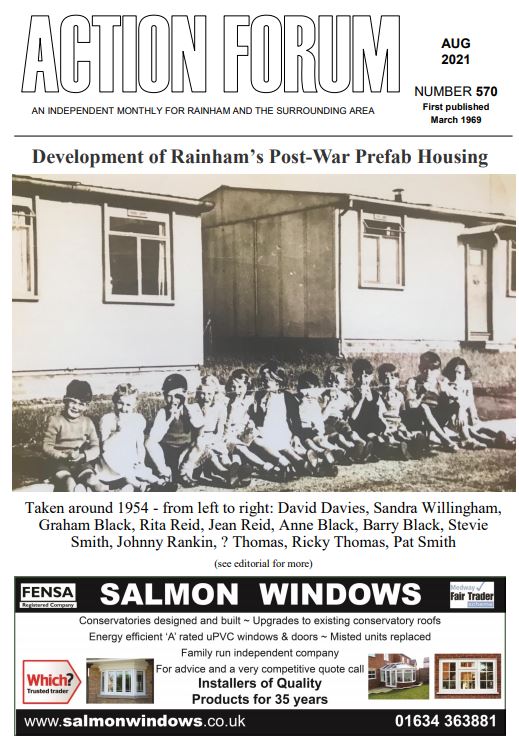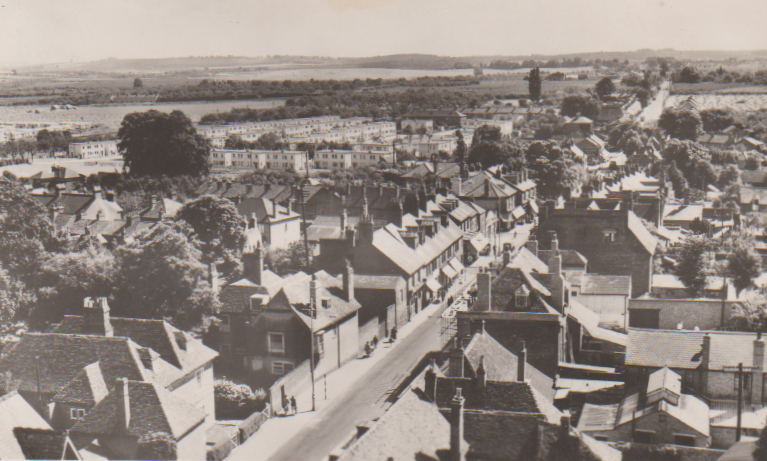This article about prefab (pre-fabricated houses from after the Second World War WW2) is based on information originally published in Action Forum in 2021 and started with the August 2021 cover photo taken on the site of what is now Clematis Avenue (off Fairview Avenue) Wigmore.

It was shared by my cousin Mrs Anne Pearce, now retired in Bexhill, and with her by her life-long friend Mrs Pat Kay. It shows the youngsters from that tight knit community and was taken by Pat ’ s late father, Mr Steve Smith. They think the photograph was taken in 1953 (the prefabricated houses having been built post war in 1947 and lasted to 1967/68 when residents were rehomed to alternative council houses in Rainham and Gillingham). They were common sights across the UK, where housing shortages were met with these asbestos and corrugated iron constructions. Loaded onto lorries the prefabs were delivered where they were needed and erected on 30ft by 22ft prebuilt brick foundations in a matter of hours. They are remembered fondly, with all ’mod cons' provided but freezing cold in winter. There were long gardens to these plots, with a shed provided, and my Uncle Bert kept chickens and grew many fruits and vegetables. There were other similar prefab communities across Rainham and Gillingham, perhaps recalled by our readers? Locations mentioned to us have been: Russells Avenue (end of Scott Avenue) and the top of Salisbury Avenue in Rainham. They were also in Scott Avenue leading from Solomon Road up to the A2 opposite Meredale School, Solomon Road and Sunderland Square, Maidstone Road (below what is now Bettescombe Road), Derwent Way, Taverners Road, Wakeley Road and some opposite the Railway Hotel by the Station. It turns out there is a prefab museum website (www.prefabmuseum.uk) which details the prefab design and origins and includes many photos and memories shared. The photo elicits for me memories of my Aunt Dolly cooking in the small kitchen, the chiming clock on her mantelpiece, the shiny brass tools around the fireplace. Strange how a single photograph can trigger so many nearly sixty year old connections. The retention of old family photographs, kept in shoe boxes or albums, some with names and dates carefully written on the back, assist our recall, whilst others lose their significance by the year as relatives pass who could put a name to a face, place or date to when they were taken. I rescued our family photo archive from Australia when my mother passed, which she had assembled over many years. Such archives are precious family treasure and dug out occasionally to refresh memories of older times.
You can see the prefabs in the distance in this photo of Rainham from 1958 which would become Sunderland Square/Scott Avenue/Russells Avenue

Your cover picture on the front of the August magazine certainly brought back childhood memories of living in a Rainham prefab, when we had not a care in the world, and the sun always shone! There were some errors in the locations mentioned. We lived in Russells Avenue, which was at the top of Solomon Road, where it still is today, not the end of Scott Avenue. There were eleven “houses” there, all of which were demolished and replaced with permanent housing in the early sixties I believe. The houses mentioned in Solomon Road, Scott Avenue and Sunderland Square were not actually prefabs; they were constructed from what was basically a steel frame with reinforced concrete panels. These houses were not intended to be temporary, as in the case of prefabs, but I believe there was an unforeseen problem with the degradation of the concrete, resulting in their premature demolition in 1997. The 38 houses in Sunderland Square were replaced by a development of over 100 houses. The main omission on your list is Mardale Road, which, along with its neighbour Wakeley Road, formed probably the biggest concentration of prefabs in Rainham. My family left Russells Avenue in 1958 to move to Gillingham, as the prefabs had already exceeded their intended lifespan, and, let’s just say they were “past their best!” I enclose a photograph of “our gang” taken in Russells Avenue in 1957. From left to right: Mick Curness (no.9); Keith Relph (no.8); my brother Keith Austin; Brian Austin (me) (no.6); and Robert Goodwin (no.4). My brother lives in Wigmore, and I in Rainham. I haven’t seen the other three for a very long time, but I believe Mick Curness went to Canada and Keith Relph to Northern Ireland. Although prefab winters had become decidedly uncomfortable by the late fifties, most of the prefab occupants I have spoken to over the years seem to remember their time in them with affection. I certainly do. P.S. In the background of the photograph my father, Jack, can be seen polishing his beloved motor bike and sidecar combination. He never seemed to be as fond of any of his subsequent cars as he was of his “bike.”










































































































































